Effects of Laser-Deposited Maraging Steel on L-PBF 316L Component
Abstract
:1. Introduction
2. Materials and Methods
2.1. DED Coating and Monitoring Setup
2.2. Materials and Heat Treatment
2.3. Experimental Details
2.4. Analysis and Characterization Procedure
3. Results and Discussion
3.1. Optical Monitoring of the DED Process
3.2. Microscopic Examination and Chemical Analysis
3.3. Low-Force Vickers Hardness Test
4. Conclusions
- The stability of the coating process was verified through the support of an optical monitoring methodology (CCD camera plus real-time image processing), which allowed the observation of the melt pool in real time.
- The hardness decreased to 200 HV at the substrate-coating interface and the first layer, starting from an average value of 235 HV in the L-PBF component. Coatings made with 3, 5, and 10 layers have a hardness equal to 375 HV (as-coated) and 580 HV (after treatment), according to the scientific literature.
- The hardness results are strongly related to the microstructural properties achieved by the as-coated and after-treatment coating. In particular, the microstructure obtained after solution annealing and age-hardening treatment is lath martensite. The aging involves the precipitation of nickel-rich intermetallic compounds in the lath martensitic structure, leading to a strengthening of the hardness by precipitation.
Author Contributions
Funding
Institutional Review Board Statement
Informed Consent Statement
Data Availability Statement
Conflicts of Interest
References
- Samei, J.; Asgari, H.; Pelligra, C.; Sanjari, M.; Salavati, S.; Shahriari, A.; Amirmaleki, M.; Jahanbakht, M.; Hadadzadeh, A.; Amirkhiz, B.S.; et al. A Hybrid Additively Manufactured Martensitic-Maraging Stainless Steel with Superior Strength and Corrosion Resistance for Plastic Injection Molding Dies. Addit. Manuf. 2021, 45, 102068. [Google Scholar] [CrossRef]
- Oh, W.J.; Lee, W.J.; Kim, M.S.; Jeon, J.B.; Shim, D.S. Repairing Additive-Manufactured 316L Stainless Steel Using Direct Energy Deposition. Opt. Laser Technol. 2019, 117, 6–17. [Google Scholar] [CrossRef]
- Lewis, S.R.; Lewis, R.; Fletcher, D.I. Assessment of Laser Cladding as an Option for Repairing/Enhancing Rails. Wear 2015, 330–331, 581–591. [Google Scholar] [CrossRef]
- Wei, S.; Wang, G.; Wang, L.; Rong, Y. Characteristics of Microstructure and Stresses and Their Effects on Interfacial Fracture Behavior for Laser-Deposited Maraging Steel. Mater. Des. 2018, 137, 56–67. [Google Scholar] [CrossRef]
- Errico, V.; Fusco, A.; Campanelli, S.L. Effect of DED Coating and DED + Laser Scanning on Surface Performance of L-PBF Stainless Steel Parts. Surf. Coatings Technol. 2022, 429, 127965. [Google Scholar] [CrossRef]
- Feenstra, D.R.; Banerjee, R.; Fraser, H.L.; Huang, A.; Molotnikov, A.; Birbilis, N. Critical Review of the State of the Art in Multi-Material Fabrication via Directed Energy Deposition. Curr. Opin. Solid State Mater. Sci. 2021, 25, 100924. [Google Scholar] [CrossRef]
- Mei, X.; Wang, X.; Peng, Y.; Gu, H.; Zhong, G.; Yang, S. Interfacial Characterization and Mechanical Properties of 316L Stainless Steel/Inconel 718 Manufactured by Selective Laser Melting. Mater. Sci. Eng. A 2019, 758, 185–191. [Google Scholar] [CrossRef]
- Chen, J.; Yang, Y.; Song, C.; Zhang, M.; Wu, S.; Wang, D. Interfacial Microstructure and Mechanical Properties of 316L /CuSn10 Multi-Material Bimetallic Structure Fabricated by Selective Laser Melting. Mater. Sci. Eng. A 2019, 752, 75–85. [Google Scholar] [CrossRef]
- Saleh, B.; Jiang, J.; Fathi, R.; Al-hababi, T.; Xu, Q.; Wang, L.; Song, D.; Ma, A. 30 Years of Functionally Graded Materials: An Overview of Manufacturing Methods, Applications and Future Challenges. Compos. Part B 2020, 201, 108376. [Google Scholar] [CrossRef]
- Kunimine, T.; Miyazaki, R.; Yamashita, Y.; Funada, Y. Effects of Laser-Beam Defocus on Microstructural Features of Compositionally Graded WC/Co-Alloy Composites Additively Manufactured by Multi-Beam Laser Directed Energy Deposition. Sci. Rep. 2020, 10, 8975. [Google Scholar] [CrossRef]
- Feenstra, D.R.; Molotnikov, A.; Birbilis, N. Effect of Energy Density on the Interface Evolution of Stainless Steel 316L Deposited upon INC 625 via Directed Energy Deposition. J. Mater. Sci. 2020, 55, 13314–13328. [Google Scholar] [CrossRef]
- Hasanov, S.; Alkunte, S.; Rajeshirke, M.; Gupta, A.; Huseynov, O.; Fidan, I.; Alifui-Segbaya, F.; Rennie, A. Review on Additive Manufacturing of Multi-Material Parts: Progress and Challenges. J. Manuf. Mater. Process. 2021, 6, 4. [Google Scholar] [CrossRef]
- Ben-Artzy, A.; Reichardt, A.; Borgonia, J.P.; Dillon, R.P.; McEnerney, B.; Shapiro, A.A.; Hosemann, P. Compositionally Graded SS316 to C300 Maraging Steel Using Additive Manufacturing. Mater. Des. 2021, 201, 109500. [Google Scholar] [CrossRef]
- Aydogan, B.; Sahasrabudhe, H. Enabling Multi-Material Structures of Co-Based Superalloy Using Laser Directed Energy Deposition Additive Manufacturing. Metals 2021, 11, 1717. [Google Scholar] [CrossRef]
- Demir, A.G.; Kim, J.; Caltanissetta, F.; Hart, A.J.; Tasan, C.C.; Previtali, B.; Colosimo, B.M. Enabling Multi-Material Gradient Structure in Laser Powder Bed Fusion. J. Mater. Process. Technol. 2022, 301, 117439. [Google Scholar] [CrossRef]
- Wei, C.; Zhang, Z.; Cheng, D.; Sun, Z.; Zhu, M.; Li, L. An Overview of Laser-Based Multiple Metallic Material Additive Manufacturing: From Macro- to Micro-Scales. Int. J. Extrem. Manuf. 2021, 3, 012003. [Google Scholar] [CrossRef]
- Félix-Martínez, C.; Ibarra-Medina, J.; Fernández-Benavides, D.A.; Cáceres-Díaz, L.A.; Alvarado-Orozco, J.M. Effect of the Parametric Optimization and Heat-Treatment on the 18Ni-300 Maraging Steel Microstructural Properties Manufactured by Directed Energy Deposition. Int. J. Adv. Manuf. Technol. 2021, 115, 3999–4020. [Google Scholar] [CrossRef]
- Blakey-Milner, B.; Gradl, P.; Snedden, G.; Brooks, M.; Pitot, J.; Lopez, E.; Leary, M.; Berto, F.; du Plessis, A. Metal Additive Manufacturing in Aerospace: A Review. Mater. Des. 2021, 209, 110008. [Google Scholar] [CrossRef]
- Jiménez, M.; Romero, L.; Domínguez, I.A.; del Espinosa, M.M.; Domínguez, M. Additive Manufacturing Technologies: An Overview about 3D Printing Methods and Future Prospects. Complexity 2019, 2019, 1–30. [Google Scholar] [CrossRef] [Green Version]
- Sarvankar, S.G.; Yewale, S.N. Additive Manufacturing in Automobile Industry. Int. J. Res. Aeronaut. Mech. Eng. 2019, 7, 1–10. [Google Scholar]
- Guerra, M.G.; Errico, V.; Fusco, A.; Lavecchia, F.; Campanelli, S.L.; Galantucci, L.M. High Resolution-Optical Tomography for in-Process Layerwise Monitoring of a Laser-Powder Bed Fusion Technology. Addit. Manuf. 2022, 55, 102850. [Google Scholar] [CrossRef]
- Campanelli, S.L.; Contuzzi, N.; Posa, P.; Angelastro, A. Study of the Aging Treatment on Selective Laser Melted Maraging 300 Steel. Mater. Res. Express 2019, 6, 66580. [Google Scholar] [CrossRef]
- Errico, V.; Campanelli, S.L.; Angelastro, A.; Dassisti, M.; Mazzarisi, M.; Bonserio, C. Coaxial Monitoring of Aisi 316l Thin Walls Fabricated by Direct Metal Laser Deposition. Materials 2021, 14, 1–17. [Google Scholar] [CrossRef] [PubMed]
- Akbari, M.; Kovacevic, R. Closed Loop Control of Melt Pool Width in Robotized Laser Powder–Directed Energy Deposition Process. Int. J. Adv. Manuf. Technol. 2019, 104, 2887–2898. [Google Scholar] [CrossRef]
- Niu, M.; Zhou, G.; Wang, W.; Shahzad, M.B.; Shan, Y.; Yang, K. Precipitate Evolution and Strengthening Behavior during Aging Process in a 2.5 GPa Grade Maraging Steel. Acta Mater. 2019, 179, 296–307. [Google Scholar] [CrossRef]
- Jiang, Y.; Cheng, Y.; Zhang, X.; Yang, J.; Yang, X.; Cheng, Z. Simulation and Experimental Investigations on the Effect of Marangoni Convection on Thermal Field during Laser Cladding Process. Optik 2020, 203, 164044. [Google Scholar] [CrossRef]
- Bidare, P.; Jiménez, A.; Hassanin, H.; Essa, K. Porosity, Cracks, and Mechanical Properties of Additively Manufactured Tooling Alloys: A Review. Adv. Manuf. 2021, 10, 175–204. [Google Scholar] [CrossRef]
- ASM International Handbook Committee. ASM Handbook (vol. 4: Heat Treating); ASM International: Geauga County, OH, USA, 1991; pp. 518–548. [Google Scholar]
- Simson, T.; Koch, J.; Rosenthal, J.; Kepka, M.; Zetek, M.; Zetková, I.; Wolf, G.; Tomčík, P.; Kulhánek, J. Mechanical Properties of 18Ni-300 Maraging Steel Manufactured by LPBF. Procedia Struct. Integr. 2019, 17, 843–849. [Google Scholar] [CrossRef]
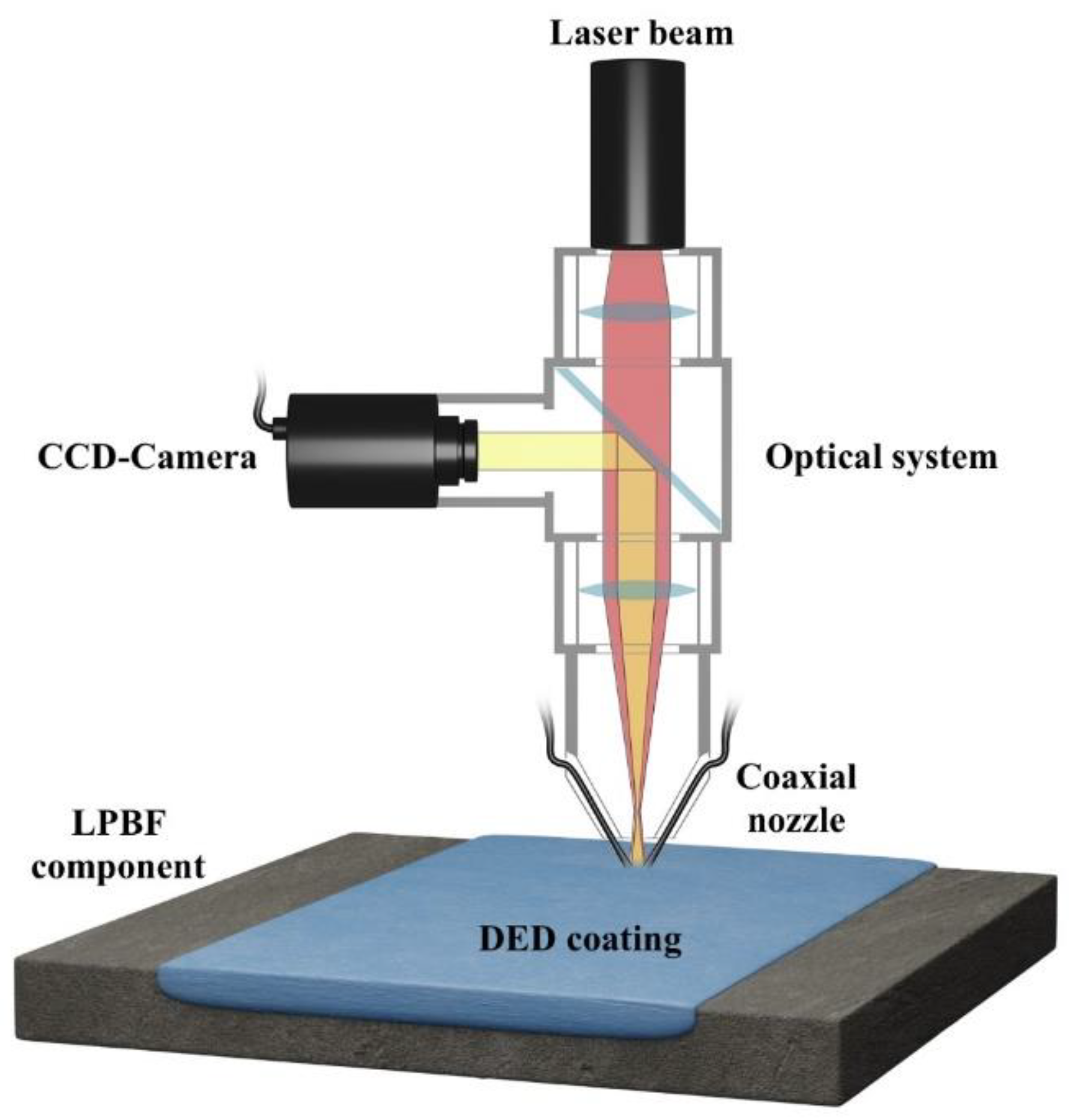
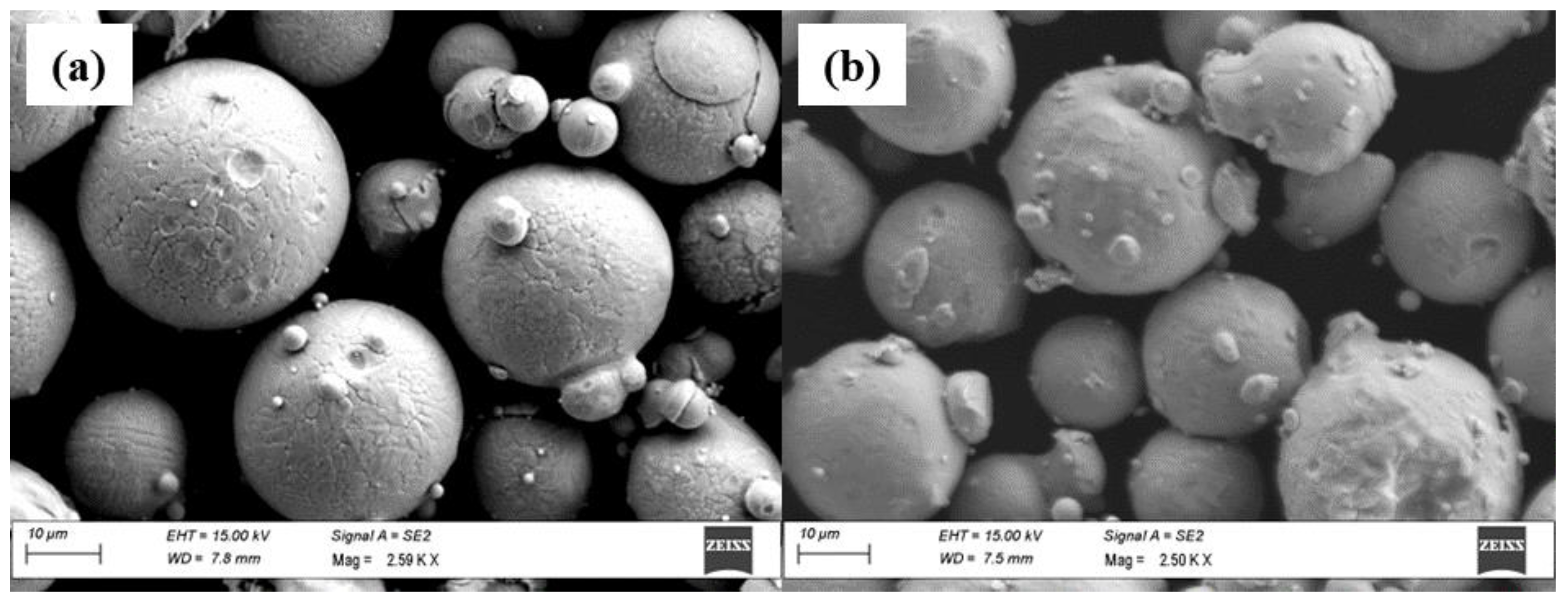
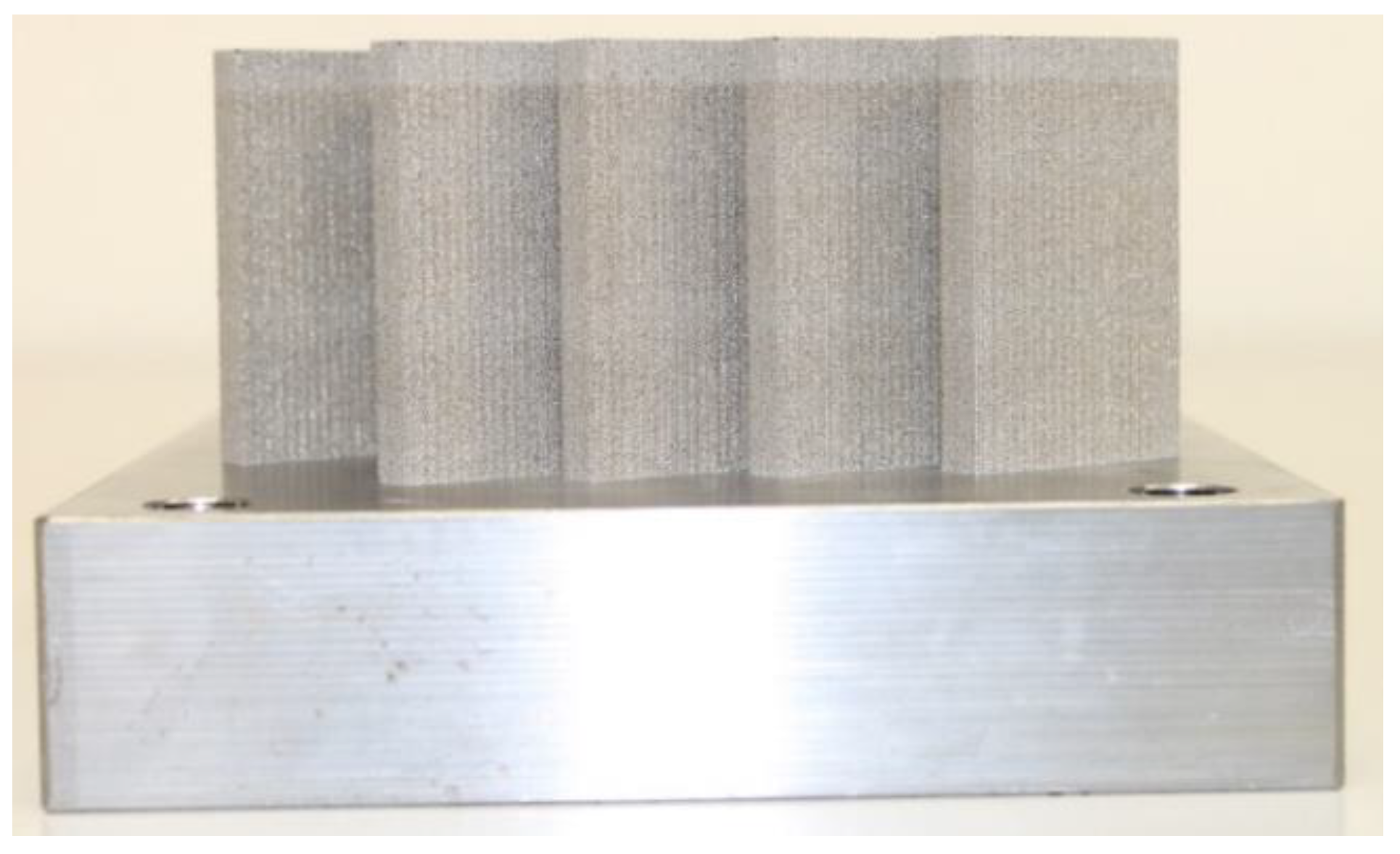

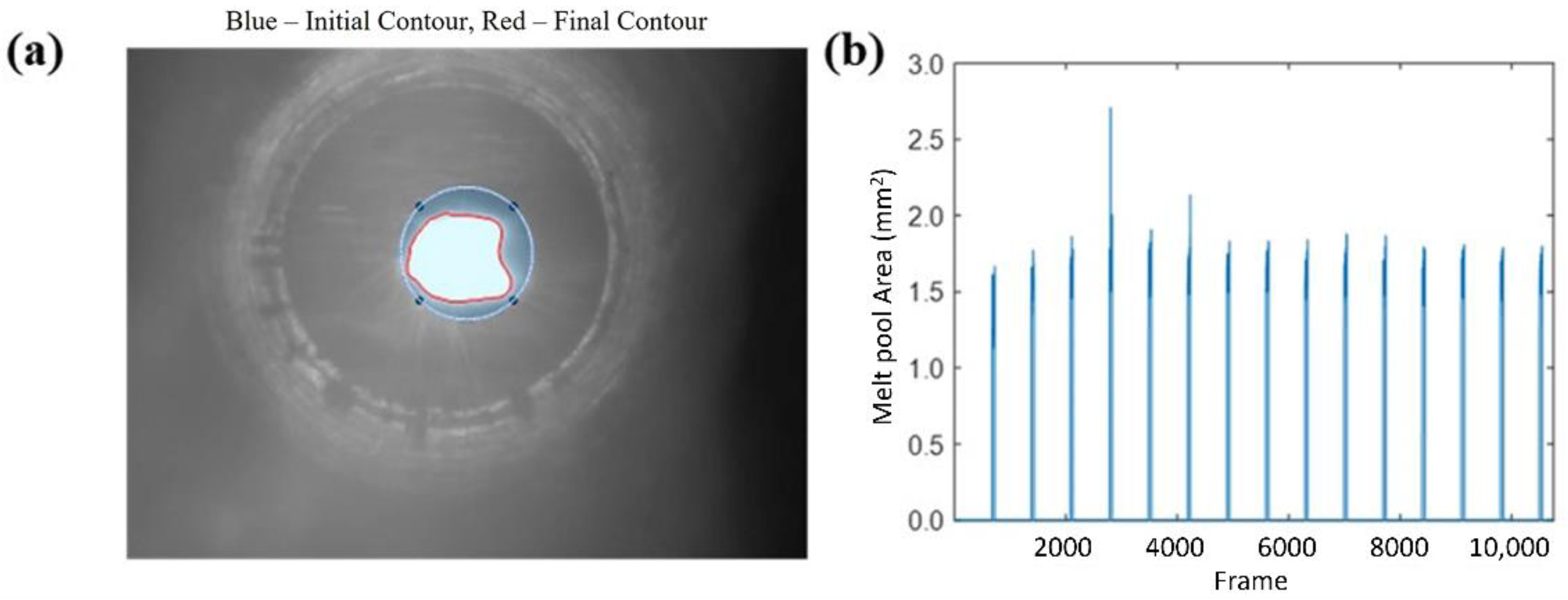
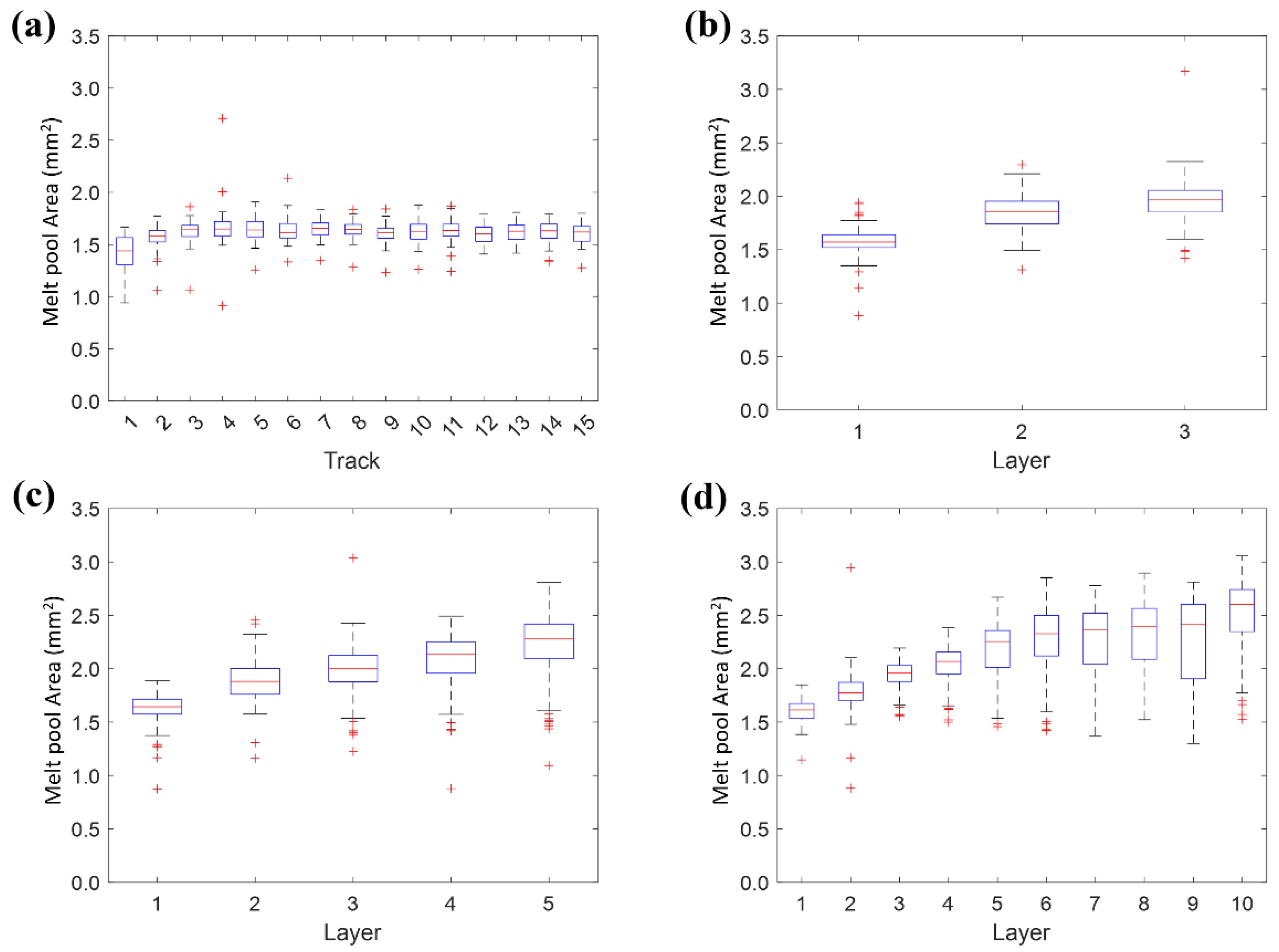
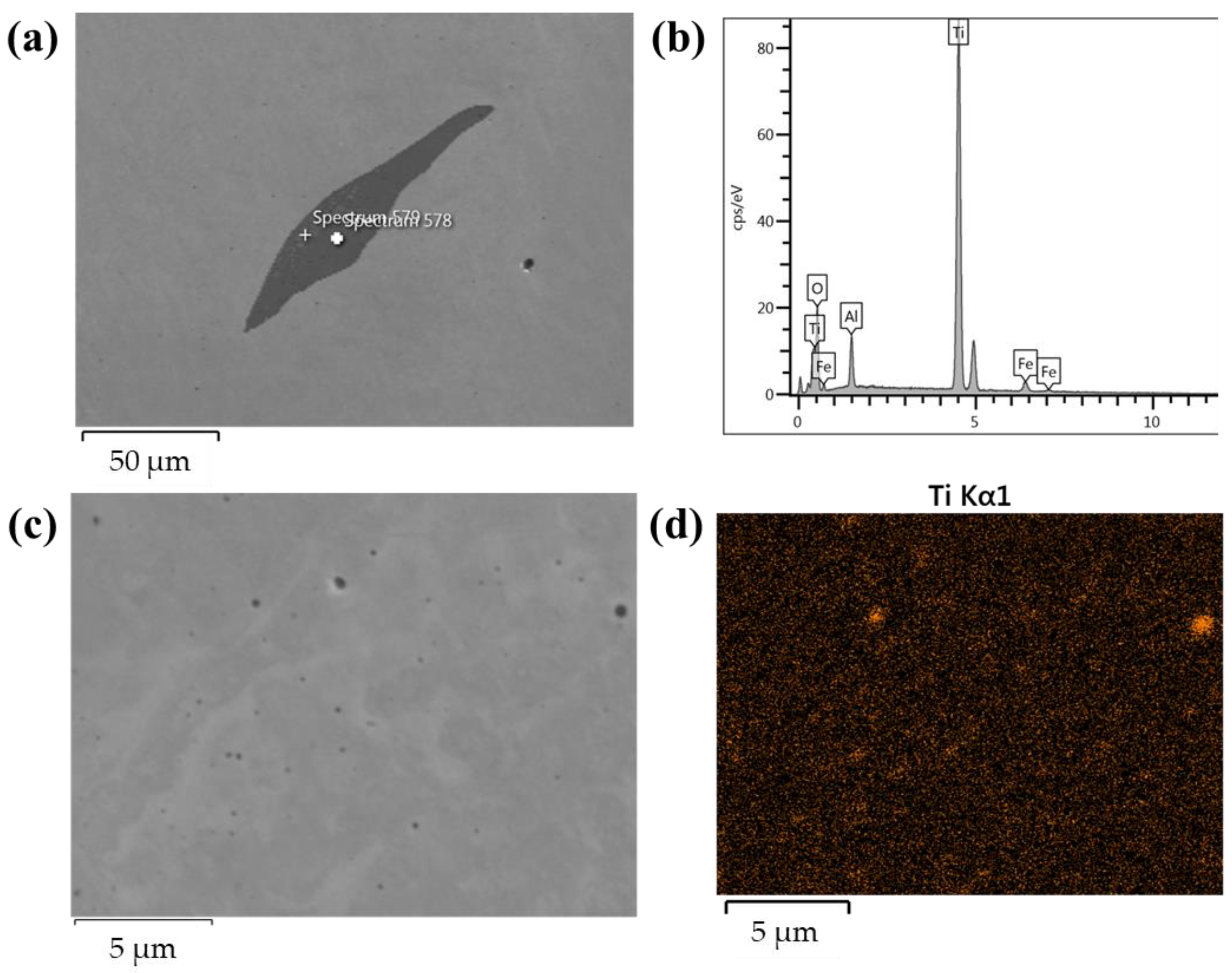


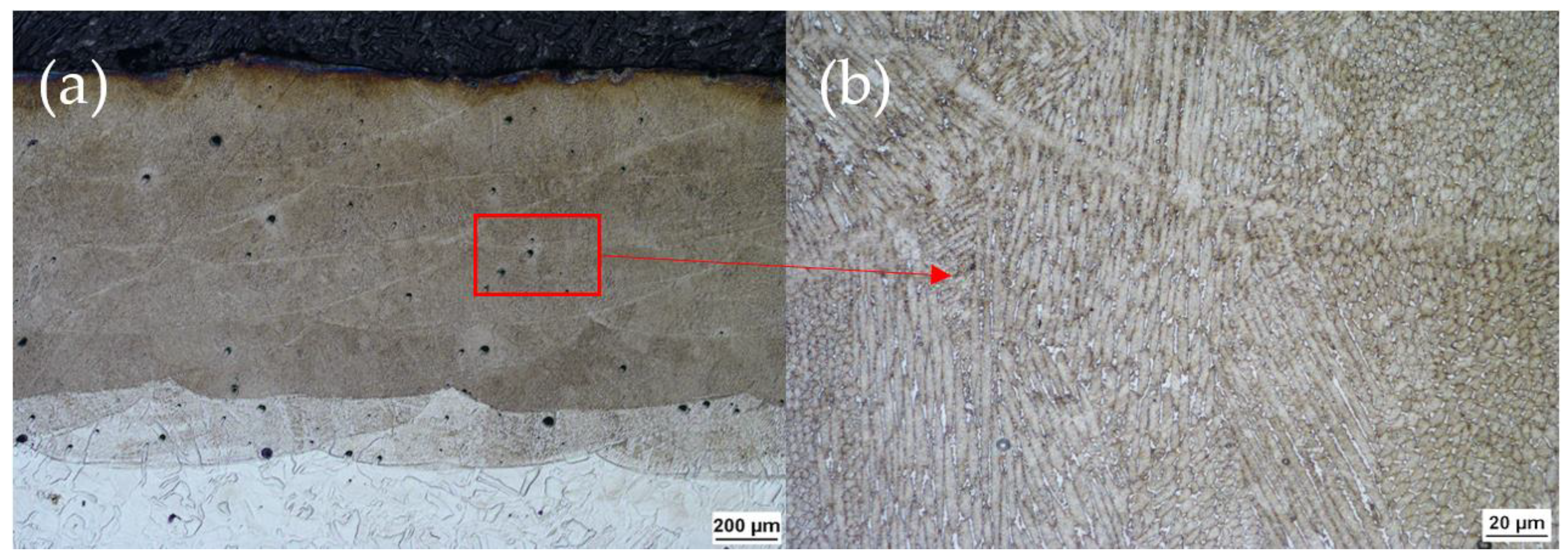

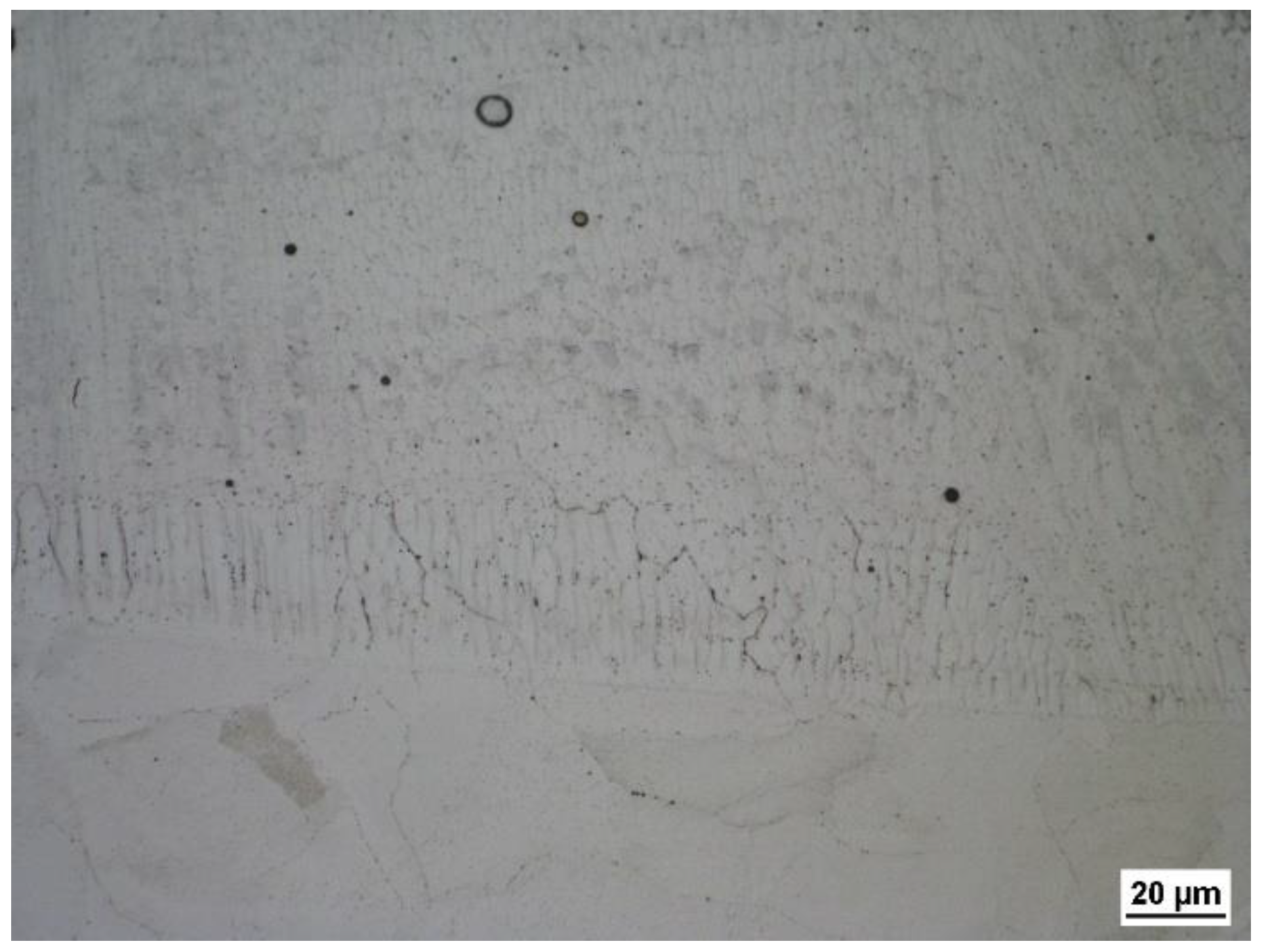

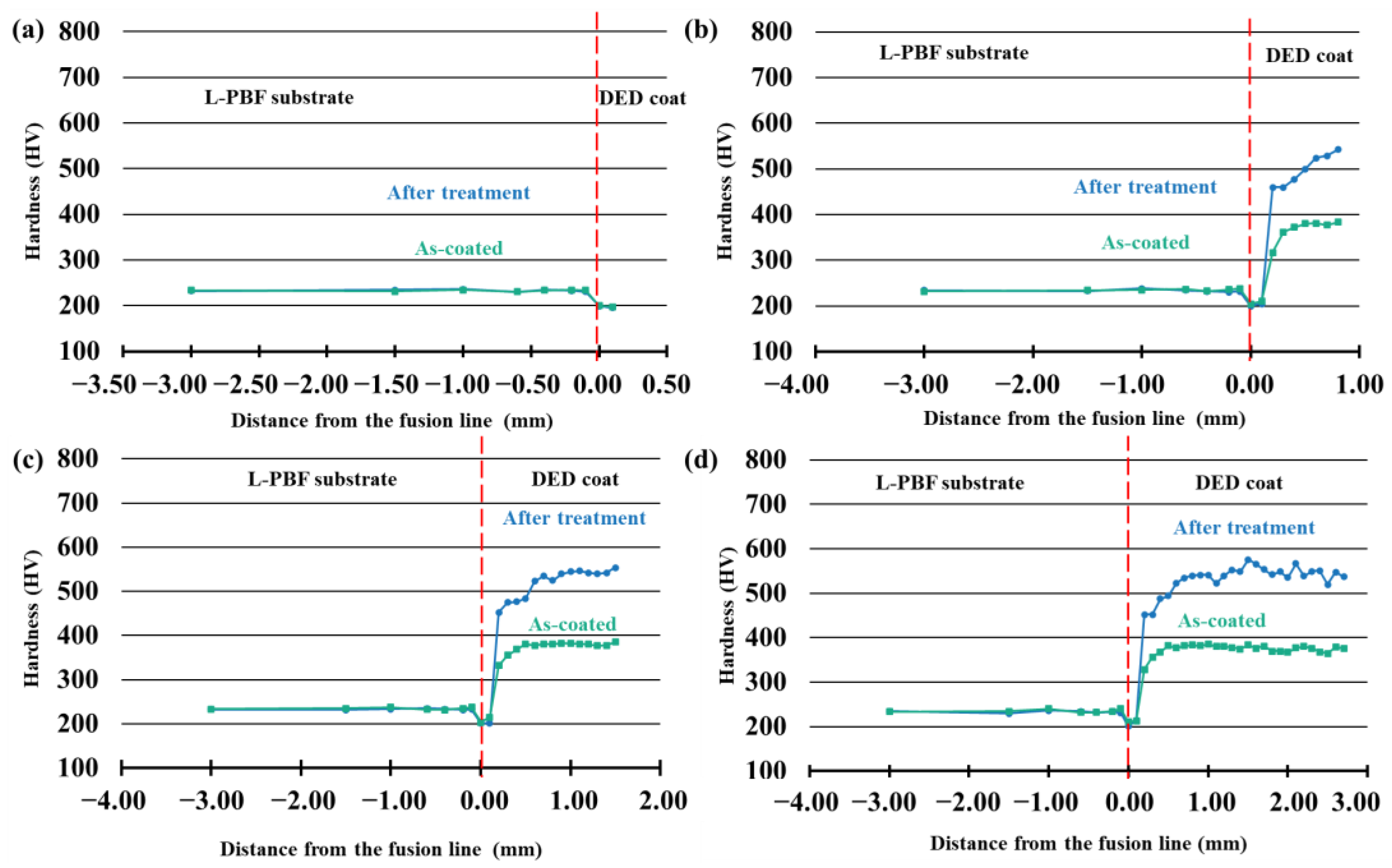
| Powder Material | Range of Particle Size (μm) | Cr | Ni | C | Mn | Si | Mo | Co | Ti | Fe |
|---|---|---|---|---|---|---|---|---|---|---|
| AISI 316L (substrate) | 15–45 | 17.8 | 11.4 | 0.012 | 1.4 | 0.45 | 2.31 | - | - | Bal. |
| 18Ni (300) (coating) | 15–53 | - | 18.7 | 0.02 | - | - | 3.73 | 10.4 | 1.15 | Bal. |
| Process Parameter | Units | Factor Levels | ||
|---|---|---|---|---|
| 1 | 2 | 3 | ||
| Laser power | W | 400 | 600 | - |
| Spot diameter | mm | 1.5 | 2.0 | 2.5 |
| Scanning speed | mm/min | 1000 | 1500 | 2000 |
| Powder feed rate | g/min | 2.5 | 5.0 | - |
| Carrier gas flow rate | L/min | 10 | 15 | - |
Publisher’s Note: MDPI stays neutral with regard to jurisdictional claims in published maps and institutional affiliations. |
© 2022 by the authors. Licensee MDPI, Basel, Switzerland. This article is an open access article distributed under the terms and conditions of the Creative Commons Attribution (CC BY) license (https://creativecommons.org/licenses/by/4.0/).
Share and Cite
Errico, V.; Posa, P.; Mazzarisi, M.; Angelastro, A.; Campanelli, S.L. Effects of Laser-Deposited Maraging Steel on L-PBF 316L Component. Metals 2022, 12, 1669. https://doi.org/10.3390/met12101669
Errico V, Posa P, Mazzarisi M, Angelastro A, Campanelli SL. Effects of Laser-Deposited Maraging Steel on L-PBF 316L Component. Metals. 2022; 12(10):1669. https://doi.org/10.3390/met12101669
Chicago/Turabian StyleErrico, Vito, Paolo Posa, Marco Mazzarisi, Andrea Angelastro, and Sabina Luisa Campanelli. 2022. "Effects of Laser-Deposited Maraging Steel on L-PBF 316L Component" Metals 12, no. 10: 1669. https://doi.org/10.3390/met12101669






